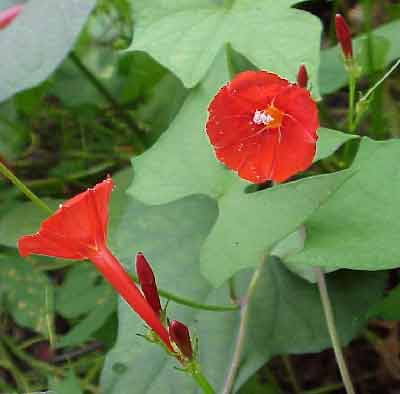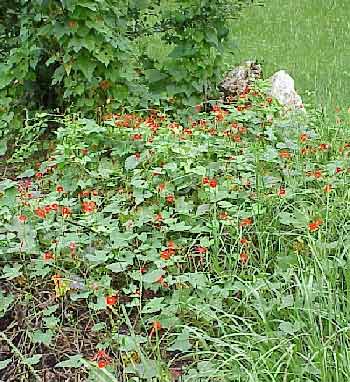
Scarlet Morning Glory
by Sharon LaPlante
Scarlet morning glory, Ipomoea hederifolia, is an annual vine in the Convolvulaceae,
or morning-glory, family. Ipomoea
coccinea and Quamoclit coccinea are two synonyms for this particular
plant.
This annual vine typically climbs upward
onto nearby vegetation by the use of tendrils.
If allowed to grow near an existing tree or other support it will climb
to well over twenty feet, however, if not supported it will grow along the
ground forming a beautiful tangle of foliage and flowers.
Scarlet morning glory occurs mostly
in disturbed sites but can also be found in hammocks, thickets and fields
throughout Florida, southern Georgia, west Texas and north to Massachusetts.
It also occurs in Mexico and the West Indies.
The leaf shape is variable, but most are
heart-shaped with three deep lobes that are pointed at the tips (apices).
Leaf sizes can vary from 1 to 4 inches in length.
Some leaves may have toothed margins, while others may not.
The leaves, stalks, and stems are generally smooth.
The brilliant scarlet flowers appear in the
summer and fall and are 1 to 2 inches in length.
They appear in small clusters with very long stalks or peduncles.
The flower tube is long and narrow with the petals flaring out to form
the bell of the ‘trumpet’. The stamens and pistil extend beyond the end of the flower.
Although the flowers are very similar in size and appearance to those of
the cypress vine (Ipomoea quamoclit) the foliage of cypress vine is
feathery in appearance and quite distinctly different than that of scarlet
morning glory.
Quarter inch round seedpods appear
throughout the summer and fall along with the flowers.
They contain four cells with each cell containing a seed. They turn dark brown when dry enough to collect.
The flowers are a nectar source for a
variety of pollinators including hummingbirds and butterflies.
Songbirds, especially cardinals, eat the seeds.
Scarlet morning glory will re-seed in the
home landscape and thrive where it was originally planted year after year
without any human interference whatsoever.
It prefers full sun, average moisture, and rich soil.
It will tolerate shadier, drier, and sandier conditions, but will not
flower as profusely and will show some yellowing of the leaves.
Many gardeners consider the morning glory to be a weed, but I have found
them to be one of the most carefree and attractive plants providing color in the
landscape and food for wildlife, and therefore, is one of my favorites.
Bell,
C. Ritchie and B. J. Taylor. Florida
Wildflowers and Roadside Plants. Laurel
Hill Press: Chapel Hill, NC. 1982
Hall,
David W., and Vernon V. Vandiver. Scarlet
Morning Glory. http://edis.ifas.ufl.edu/BODY_FW020
Hall,
David W. Illustrated Plants of
Florida and the Coastal Plain. Maupin
House Publishing: Gainesville, FL. 1993
Taylor,
Walter Kingsley. The Guide to Florida Wildflowers.
Taylor Publishing: Dallas, TX 1992
Wunderlin,
Richard P. Guide to the Vascular
Plants of Florida. University
Press of Florida: Gainesville, FL. 1998
ãSept
2001
Return to the Main Page
All material on this site © Hernando Chapter of the FNPS. The materials on this website may be copied and distributed without permission, provided that it is used for non-commercial, informational or educational purposes, and you acknowledge this site and the Hernando Chapter of the Florida Native Plant Society as the source of publication.